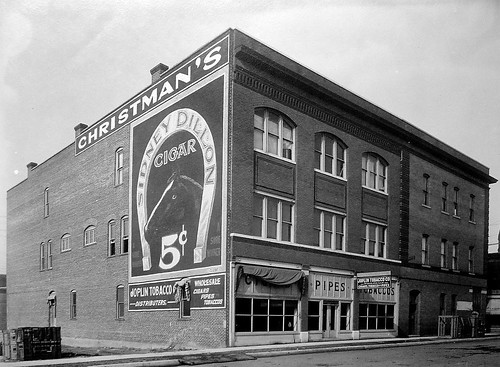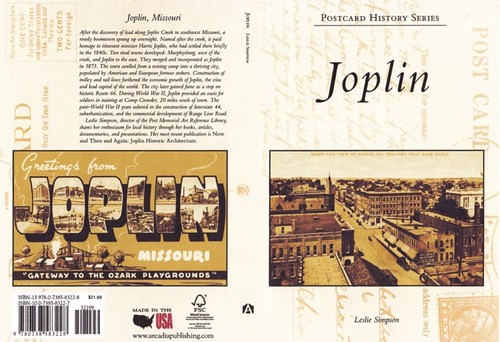Previously, we brought you views of Joplin from The City that Jack Built: Joplin, 1902. This time we offer more views of Joplin, this time from Joplin: City of Wealth, Industry and Opportunity, from approximately 1913. Just like The City That Jack Built, City of Wealth, Industry and Opportunity, was created as a means to advertise Joplin’s attractive qualities to the world at large. By 1913, Joplin was quickly approaching what might be considered it’s architectural peak, with many of her most beautiful buildings being completed by this decade and the next. It was the age of Michaelis, Allen and Garstang & Rea, and a time period when Joplinites held no doubt that their city was on its way to bigger and better things. To get a more static view of the photographs featured in the video below, just follow this link.
A City of Wealth and Industry: Joplin 1913 Moving Pictures
Alfred W. Rea: An Architect’s Portfolio
One of the joys of researching the past is serendipitously stumbling across a wonderful discovery, but sometimes a wonderful discovery finds you. We are excited to announce that a relative of preeminent Joplin architect Alfred W. Rea contacted us last week and informed us that he will generously share photographs of roughly seventy-six different buildings that Rea and his partner, Charles E. Garstang, designed during their time in Joplin.
Alfred Willemin Rea was born on August 12, 1869, in Decatur, Illinois. He attended the University of Illinois and graduated with a B.A. in 1893. Rea worked as a draftsman in several architectural firms, including Wigg & Mahurin (Ft. Wayne, Indiana); J.W. Ross (Davenport, Iowa); Reeves & Baillie (Peoria and Decatur, Illinois). He later partnered with Charles E. Garstang and established Garstang & Rea in Joplin in 1901. The firm later relocated to Los Angeles, California, where Garstang and Rea continued to design buildings until their retirement in the 1940s.
The whereabouts of the papers and portfolio of Garstang are currently unknown, but Rea’s portfolio is comprehensive. Fortunately, because Rea labelled the majority of the photographs in his portfolio, we believe that the photos and their labels will provide the most complete list of Garstang & Rea’s work known to date. The firm, it turns out, not only designed buildings in Joplin, but designed buildings in Monett and Nevada, Missouri, and Winfield, Kansas.
We will work to place these photos online so that others can enjoy them and celebrate the work of two of Joplin’s finest architects. The images will appear on Historic Joplin and on Flickr with the permission of the owner.
If you have photos you would like to share with Historic Joplin, let us know: HistoricJoplin@gmail.com
Review of “Joplin” by Leslie Simpson
Leslie Simpson, the director of the Post Memorial Art Reference Library, writes in the epilogue of Joplin, “This book is my love letter to the city of Joplin, of which I am proud to be a citizen!”
Simpson’s latest book is a wonderful love letter to Joplin, a fine work that covers the history of the city from its establishment in 1873 to the present day. It is a lavishly illustrated postcard history of the city accompanied by detailed, informative captions. The book provides readers with an understanding of the people, places, and events that shaped Joplin into the city that it is today. Simpson does an excellent job of balancing the past and present so that readers are taken through Joplin’s early years, subsequent growth, Route 66 years, up until the time of the tornado.
The book is helpfully divided into nine sections that cover different topics such as mining, industry, residences, schools, churches, and hotels. Although one might expect that because the book is postcard history the book might be poorly researched, it is not. The captions for each illustration are insightful, well written, and historically accurate. Each illustration has been carefully chosen and offer unique glimpses into Joplin’s social, cultural, religious, and architectural history.
Sadly, Simpson’s work illustrates just how many Joplin buildings and other landmarks have been lost to the ravages of time, benign neglect, or lack of vision. Our advance copy notes that “Profits from the sale of this book will be donated to the Joplin Chamber of Commerce Business Recovery Fund” so you can be assured that your money will go to a good cause. We also recommend that you might consider giving a donation the Post Memorial Art Reference Library.
Those who own Leslie Simpson’s prior works may recognize some, but not all of the images used, however all offer entertaining glimpses into Joplin’s past. For those who have and enjoyed the above mentioned Now and Then and Again, they have a great companion to Joplin.
Joplin is a well written and illustrated history of Joplin, Missouri. It is accessible to readers of most ages and is a enjoyable read for those who enjoy local history, the history of Joplin, and illustrated histories. Hopefully it will leave most readers with an even greater appreciation for the City that Jack Built.
Joplin, $21.99, Arcadia Publishing
Available at Hastings and through the publisher at www.arcadiapublishing.com




